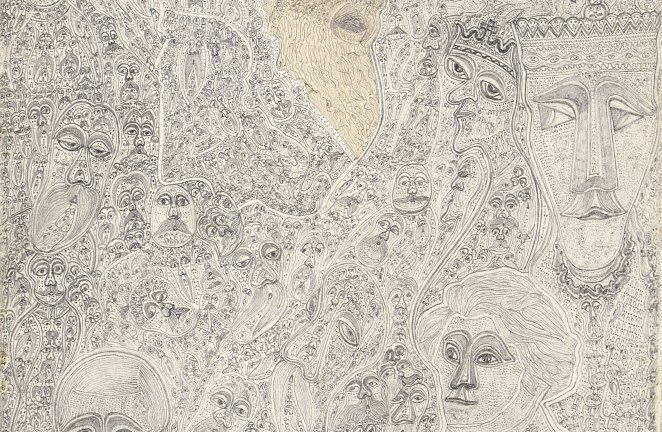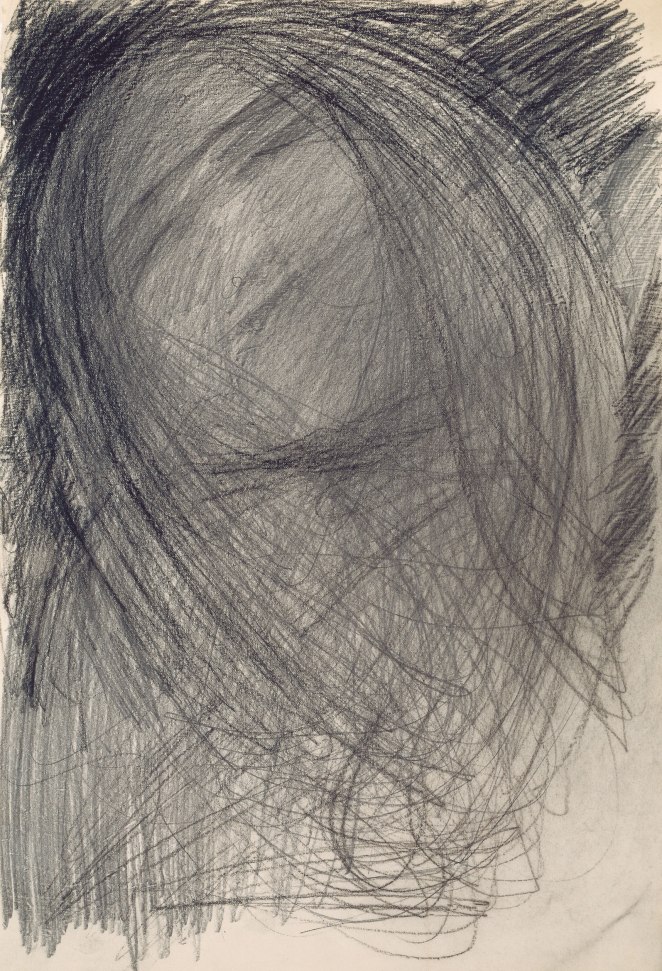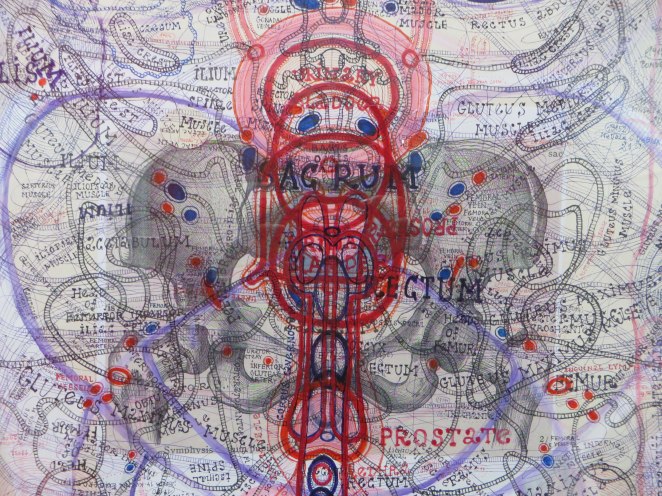Maison Rouge is transformed into a labyrinth of rooms packed with overwhelming art brut, mostly drawings. One incredible drawing follows the next; I wanted to have them all. The exhibition is so inspiring that you want to run home, take a piece of paper, a pencil and start drawing.
The large amount of art works is easily explained knowing that the collection they are taken from consists of 3,500 works. Maison Rouge has limited itself to show ‘only’ 400 works by 200 artists. It is stated that the collection abcd (art brut connaissance & diffusion) by Bruno Decharme is the most important art brut collection in the world. That I don’t know. But that Decharme, who started his career in the film industry as the assistant of Jacques Tati, has devoted himself to his collection for over thirty years is clearly visible.
The most beautiful expressions can be found. Waves of colour accentuated by black lines are drawn in various sizes. The drawing displays an appealing rhythm and incredible depth. I’m amazed to learn it’s made (by an anonymous artist in Austria) in 1910. It could have been made yesterday! Quite a few pieces possess this quality of timelessness.
The Japanese Yuichi Saito (1983) masters the scratch. I’ve never seen such strong drawings consisting solely of black scratches. Same goes for the French Fernand Desmoulin (†1914). Why does it look so convincing and so coherent when they scratch and so poor when I do? Is it the wit that sets us apart?
The celestial gardens and houses by Victorien Sardou are etched in incredible delicate lines (1860). Looking at his drawings one hears the angels sing. The French playwright developed an interest in spiritism. Mozart and Bernard Palissy dictated his drawings from their heavenly lodgings. This must be one of the oldest pieces in Decharme’s collection. His incredible rich collection, ranging from the mid-1800s to the present day, covering all corners of the world, shows the full potential of art brut.
Bruno Decharme and Antoine de Galbert, founder of Maison Rouge and art brut collector in his own right, curated the show together. They devised subthemes like Language Games, Scientific Heterotopias, Mental Maps, Anarchitecture, Madness of the Flesh and Saving the World to shed light on the various artworks. Art pieces stemming from different times and places are juggled.
Maison Rouge has paid attention to art brut in various exhibitions. The juxtaposition of the erotic, ceramic sculptures by contemporary artist Elmar Trenkwalker to early twentieth century outsider Augustin Lesage for example was quite notable (2008). The abcd collection has chosen the right venue to unfold their treasures.
Such a pleasure to be surrounded by unpretentious art works. These pieces were made out of sheer joy or out of an inner necessity. The self-taught artists display a lifelong devotion to their body of work. Work that was made in psychiatric hospitals or in private houses often withdrawn from society. Work that is not polluted by the pursuit of acknowledgement, fame and wealth. A refreshing attitude especially in a time when social media demand instant publishing, instant audience and instant success.
These autodidacts followed their instincts against the grain of time. They couldn’t care less about Cubism, Dada, Abstract Expressionism, Postmodernism and all that. This is one of the reasons why art brut appealed so much to the Surrealists and to Jean Dubuffet who coined the term Art Brut in 1945. Art brut can be regarded as a sort of back to basics. It shows what can happen if art is freed from all ballast.
The difficulty is of course whether art brut can be judged the same way as Art Culturel (as Dubuffet named the established art). I’m afraid I valued some works incorrectly. I considered the scratches in Saito’s work as an abstract gesture whereas I read afterwards that Saito is merely writing down the names of his favourite TV shows in Japanese characters…
It’s remarkable that various artists have their hang-up. Alexandre Pavlovitch Lobanov (†2003, Russia) always depicts himself in a heroic manner, surrounded by guns and other arms, Kunizo Matsumoto (1962, Japan) scribbles his Japanese characters on calendars only, Miroslav Tichý (†2011, Czech Republic) aimed his peeping homemade camera’s solely on women and Hans-Jörg Georgi (1949, Germany) fabricates airplanes out of carton.
I find it notable that many art brut pieces suffer from horror vacui. Every millimetre of the paper or linen needs to be covered. Take for instance the giant book by Charles August Albert Dellschau (†1923), butcher and aviation visionary. He bound the book himself, decorated the pages with newspaper articles and surrounded them by watercolours. He must have spent hours and hours and hours, if not all of his time, to fabricate this book. The result looks like an Egyptian artefact that needs to be deciphered. A secret world is hidden in this vast volume. I’m surprised Hollywood hasn’t discovered art brut yet. Many fantasy film scripts could be deducted from it.

Hans-Jörg Georgi’s airplanes contain brothels, dancings, bowling alleys and sleeping cabins, so he says
Roaming through the exhibition brings a few questions to mind. Why are there so few women outsider artists? Even fewer than in established art. Why are the majority of the art pieces drawings? Why are there so little sculptures (the small magic objects set aside) and photography? Do outsider artists prefer the pencil or does Decharme collect mainly drawings?
And when is one considered to be an art brut artist? Some works are made by men hospitalized in psychiatric institutions, others lead their lives in society. Does one need to be self taught and mentally ill (or suffer from autism or Asperger) to be an art brut artist? Or will self-taught and working in voluntary confinement, or being unworldly, a hermit or an outcast do as well?
A question of ethics pops up too. Henry Darger’s drawings are sold for astronomic sums of money. His work is discovered after his death, no exploitation there. What about the living artists with the mental awareness of a child? Who owns their work and their money? Although these age-old questions are not addressed, it’s worthwhile pondering about them while enjoying the show. Art brut still has some issues to tackle.
> > > art brut, collection abcd / bruno decharme, Oct. 18 – Jan. 18 2015, La Maison Rouge, Paris







